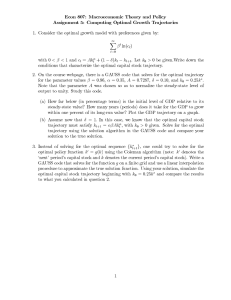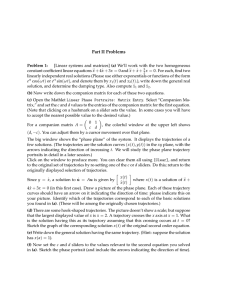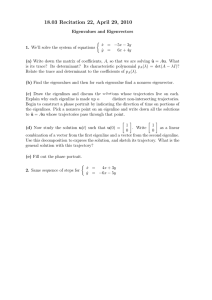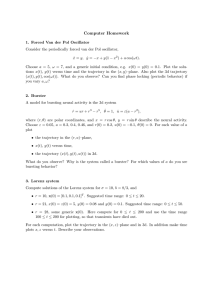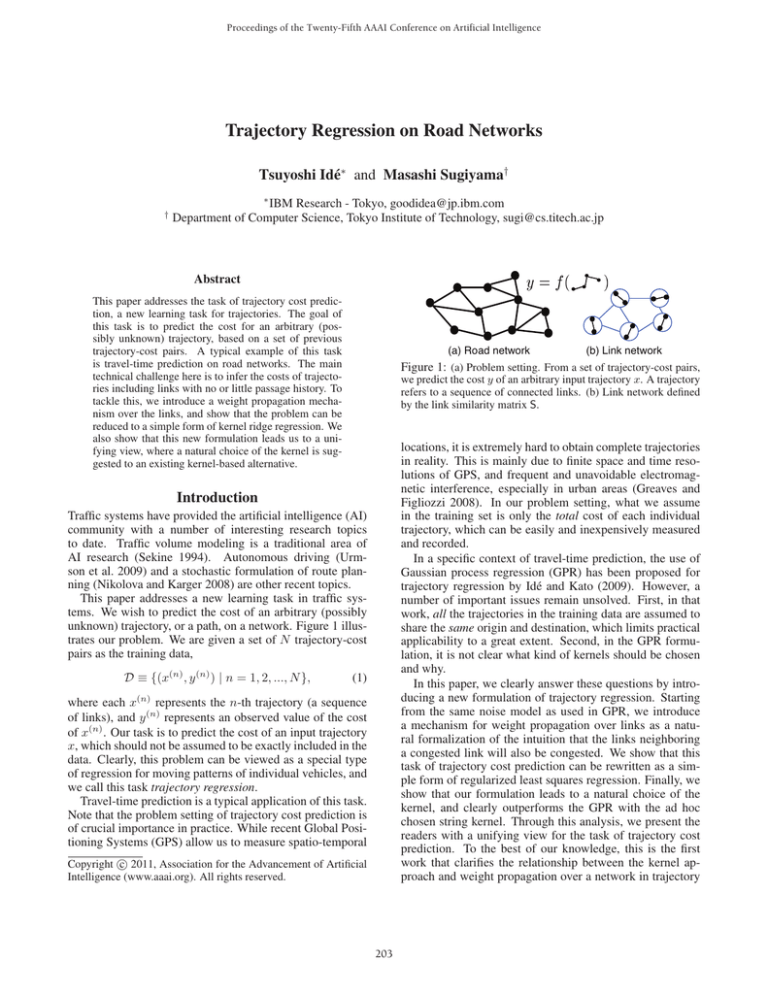
Proceedings of the Twenty-Fifth AAAI Conference on Artificial Intelligence
Trajectory Regression on Road Networks
Tsuyoshi Idé∗ and Masashi Sugiyama†
∗
†
IBM Research - Tokyo, goodidea@jp.ibm.com
Department of Computer Science, Tokyo Institute of Technology, sugi@cs.titech.ac.jp
Abstract
This paper addresses the task of trajectory cost prediction, a new learning task for trajectories. The goal of
this task is to predict the cost for an arbitrary (possibly unknown) trajectory, based on a set of previous
trajectory-cost pairs. A typical example of this task
is travel-time prediction on road networks. The main
technical challenge here is to infer the costs of trajectories including links with no or little passage history. To
tackle this, we introduce a weight propagation mechanism over the links, and show that the problem can be
reduced to a simple form of kernel ridge regression. We
also show that this new formulation leads us to a unifying view, where a natural choice of the kernel is suggested to an existing kernel-based alternative.
(a) Road network
we predict the cost y of an arbitrary input trajectory x. A trajectory
refers to a sequence of connected links. (b) Link network defined
by the link similarity matrix S.
locations, it is extremely hard to obtain complete trajectories
in reality. This is mainly due to finite space and time resolutions of GPS, and frequent and unavoidable electromagnetic interference, especially in urban areas (Greaves and
Figliozzi 2008). In our problem setting, what we assume
in the training set is only the total cost of each individual
trajectory, which can be easily and inexpensively measured
and recorded.
In a specific context of travel-time prediction, the use of
Gaussian process regression (GPR) has been proposed for
trajectory regression by Idé and Kato (2009). However, a
number of important issues remain unsolved. First, in that
work, all the trajectories in the training data are assumed to
share the same origin and destination, which limits practical
applicability to a great extent. Second, in the GPR formulation, it is not clear what kind of kernels should be chosen
and why.
In this paper, we clearly answer these questions by introducing a new formulation of trajectory regression. Starting
from the same noise model as used in GPR, we introduce
a mechanism for weight propagation over links as a natural formalization of the intuition that the links neighboring
a congested link will also be congested. We show that this
task of trajectory cost prediction can be rewritten as a simple form of regularized least squares regression. Finally, we
show that our formulation leads to a natural choice of the
kernel, and clearly outperforms the GPR with the ad hoc
chosen string kernel. Through this analysis, we present the
readers with a unifying view for the task of trajectory cost
prediction. To the best of our knowledge, this is the first
work that clarifies the relationship between the kernel approach and weight propagation over a network in trajectory
Introduction
Traffic systems have provided the artificial intelligence (AI)
community with a number of interesting research topics
to date. Traffic volume modeling is a traditional area of
AI research (Sekine 1994). Autonomous driving (Urmson et al. 2009) and a stochastic formulation of route planning (Nikolova and Karger 2008) are other recent topics.
This paper addresses a new learning task in traffic systems. We wish to predict the cost of an arbitrary (possibly
unknown) trajectory, or a path, on a network. Figure 1 illustrates our problem. We are given a set of N trajectory-cost
pairs as the training data,
D ≡ {(x(n) , y (n) ) | n = 1, 2, ..., N },
(b) Link network
Figure 1: (a) Problem setting. From a set of trajectory-cost pairs,
(1)
where each x(n) represents the n-th trajectory (a sequence
of links), and y (n) represents an observed value of the cost
of x(n) . Our task is to predict the cost of an input trajectory
x, which should not be assumed to be exactly included in the
data. Clearly, this problem can be viewed as a special type
of regression for moving patterns of individual vehicles, and
we call this task trajectory regression.
Travel-time prediction is a typical application of this task.
Note that the problem setting of trajectory cost prediction is
of crucial importance in practice. While recent Global Positioning Systems (GPS) allow us to measure spatio-temporal
c 2011, Association for the Advancement of Artificial
Copyright Intelligence (www.aaai.org). All rights reserved.
203
include nonlinear terms such as e,e ∈x le,e fe fe . However, we believe that the main contribution is captured by
the linear term as in Eq. (4) since such a nonlinear term is
not consistent with the intuition that m(x) is roughly proportional to |x|, the number of links in x. Instead of using
a complex nonlinear model in m(x), we take account of the
effect of inter-link interactions in the framework of weight
propagation as discussed later.
regression.
Problem Setting
As described in Introduction, we assume that we are given a
data set of N trajectory-cost pairs as Eq. (1). Our goal is to
predict the cost y spent along a given trajectory x including
possibly unseen links on the network.
To make the problem tractable, we restrict our attention
to trajectories on networks, where a trajectory is represented
as a sequence of link identifications (IDs). We denote the
number of links in the entire network by M . Even in this
case, however, the dataset D cannot span all of the possible
trajectories since the number of possible trajectories in a network is of a factorial order. Thus, simple strategies such as
k-nearest neighbor regression will not work. In addition, in
realistic situations, the distribution of the amount of traffic
is not at all uniform. In other words, some links have an extremely high number of passages, while others have almost
no passages, as shown later by our experiments.
To summarize, main technical challenges are (1) how to
handle trajectories including unseen links, and (2) how to
handle heterogeneity over the link traffic.
Loss function
Now our goal is to determine the state variables {fe } from
the data D. Based on the Gaussian observation model, one
natural approach for learning {fe } is the maximum likelihood. Equivalently, one can minimize the negative loglikelihood given by
N 2
y (n) − m(x(n) |f ) ,
(5)
L(D, f ) ≡
n=1
where we omitted constant terms and the unimportant prefactor. This is a well-known quadratic loss function.
By using Eq. (4), it appears that minimizing this loss function is sufficient to find the solution. However, this is not
true in general. As mentioned before, the trajectories in D
are not expected to include all of the links. Some of the links
do not appear in the loss function and are left undetermined.
It is clear that using the baseline costs for such links is not a
good solution, since such static information does not reflect
any changes in the actual traffic flow.
Predicting the cost of a trajectory including any unseen
links appears to be difficult. However, introducing another
assumption that we call weight propagation makes it possible. We look at this approach in the next subsection.
Weight Propagation Model
This section explains how to formalize our task of trajectory cost prediction. First, we look at how to parameterize
the link cost. Then we consider the important issue of how
to handle little- or no-passage links, and introduce a weight
propagation mechanism.
Parameterizing link cost
We start with the assumption about the observation noise for
the cost y of a trajectory x as used in the GPR formulation:
p(y|x) = N (y|m(x), σ 2 ),
Propagation penalty
(2)
One of the most important features of networks is the fact
that an event at one location can propagate to the neighboring locations through the connecting links. Thus, if a
link e has a significant deviation from its baseline state, then
e’s neighboring links are expected to be influenced by that
large deviation. This effect is easily understood by thinking
about traffic jams. For example, if 5th Avenue in Manhattan,
New York, becomes jammed by traffic, then we naturally
expect traffic jams on neighboring Park Avenue and 53rd
Street. This suggests that the state variables should satisfy a
smoothness condition while minimizing the loss function.
Encouraged by this analysis, we introduce a penalty term
into the loss minimization problem,
where N (·|m, σ 2 ) denotes a Gaussian distribution with the
mean m and the variance σ 2 . To consider the functional
form of m(x), let us first look at the simplest situation. If
there is no interaction between the moving objects, the mean
trajectory cost will be simply given as
le φ0e ,
(3)
m0 (x) ≡
e∈x
where le is the length or weight of a link e, and φ0e (which
we assume known) is a constant representing the cost spent
per unit length at e under the condition of no interaction. In
travel-time prediction, the total time spent is the sum over
the contributions of the individual links.
If an interaction exists between the objects, m0 (x) will
not be a good approximation. To handle the deviation from
the baseline cost, we introduce state variables {f1 , ..., fM }
for the individual links. Then we can generally express the
cost m(x) as
le (φ0e + fe ),
(4)
m(x|f ) =
1
2
Se,e |fe − fe | ,
2 e=1 M
R(f ) ≡
M
(6)
e =1
where M is the number of links, and the M × M matrix S
is an affinity matrix between the links (see Fig. 1 (b)). One
reasonable choice of S is a finite-range exponential function
such as
⎧
e = e ,
⎪
⎨1
e∈x
Se,e ≡
where we explicitly denoted in m the dependency on f ≡
[f1 , ..., fM ] . This is our basic model for m(x). One might
204
⎪
⎩
ω d(e,e )
d(e, e ) ≤ d0 ,
0
otherwise,
(7)
where Se,e is the (e, e ) element of S, and ω is a positive
constant less than 1. The exponent d(e, e ) is the distance
between e and e . The simplest choice for this is to use one
plus the minimum number of hops from e to e . For example, a link e sharing the same intersection with e has 0 hops
to e, so d(e, e ) = 1 and Se,e = ω. While the threshold d0
has several possibilities, our observation shows that a small
value such as 2 or 3 works in many cases if λ is optimized
appropriately. Note that a finite value of d0 corresponds to
the common sense notion that a traffic blockage at 5th Avenue will not affect streets in Los Angeles, California. Also,
our formulation allows us to handle directional networks by
treating individual directions as different links. Thus we assume Se,e = Se ,e hereafter.
Clearly, R(f ) controls the smoothness over the links. If
one link has a large difference in fe compared to a neighboring link, then R(f ) imposes a large penalty. In contrast, if
the values of the state variables are the same in neighboring
links, then this term makes no contribution.
Combining Eqs. (5) and (7), our final objective function
is written as
N 2
y (n) − m(x(n) |f )
Ψ(f |λ) =
This is the objective function of regularized least squares
regression, and the global optimum solution f ∗ is given as
the solution of the simultaneous equation
(14)
QQ + λL f = QyN .
Fortunately, QQ + λL is quite sparse, real, and symmetric,
and this equation can be efficiently solved with the use of
iterative algorithms such as conjugate gradient (CG) (Golub
and Loan 1996).
Optimizing λ
So far, we have treated the regularization parameter λ
as a fixed constant. This parameter, however, can be
learned from the data by minimizing the leave-one-out
cross-validation (LOO CV) error,
N
2
1 (n)
ỹ − q (n) f (−n)
LLOOCV (λ) ≡
(15)
N n=1
with respect to λ. Here, f (−n) is the solution of Eq. (14) for
the n-th leave-one-out data defined as {(x(n) , y (n) ) | n =
1, 2, ..., n − 1, n + 1, ..., N }. In the case of regularized least
squares regression, it can be shown that one can remove the
summation over n to give
2
1 LLOOCV (λ) =
[diag(IM − H)]−1 (IM − H)y (n) ,
N
(16)
where H is defined by H ≡ Q [QQ + λL]−1 Q. Also, IM is
the M -dimensional identity matrix, and diag is the operator
to set all of the off-diagonal elements to zero. To find the
optimal λ, we need to repeatedly evaluate the value of this
LOO CV score for a number of different values of λ.
n=1
λ
2
Se,e |fe − fe | ,
2 e=1 M
+
M
(8)
e =1
where λ is a constant that controls the tradeoff between the
penalty and the loss, and is determined based on cross validation as explained later.
Matrix representation of the objective
Algorithm summary
For deeper insight, we derive a matrix representation of
Eq. (8). First, for the penalty term, simply by expanding
the square, we see that
In the training phase, we first determine the best λ based
on the LOO CV cost function. Then we solve a regularized
least squares regression problem to get the state variable f .
1. Input: Q, yN , and the Laplacian matrix L.
2. Algorithm:
• Find λ∗ that minimizes LLOOCV (Eq. (16)).
• Solve Eq. (14) using the λ∗ .
3. Output: f .
In the training phase, the most expensive step is the LOO
CV to optimize λ. In this step, for each value of λ, we need
to solve [QQ + λ]X = Q w.r.t. X so that H = Q X. While
this is an O(M 3 ) operation in general, thanks to the sparsity
of QQ + λ, the CG algorithm allows to perform this step in
O(M 2 ) in practice, provided that the number of nonzero entries is of O(M ). The memory requirement is also O(M 2 ).
In the test phase, for an input trajectory x, we compute
y=
le (fe + φ0e ).
(9)
R(f ) = f Lf ,
M
where L is defined as Li,j ≡ δi,j k=1 Si,k − Si,j , and δi,j
is Kronecker’s delta function. This is the definition of the
graph Laplacian induced by the affinity matrix S.
Second, for the loss term, let ỹ (n) be
le φ0e ,
(10)
ỹ (n) ≡ y (n) −
e∈x(n)
and define yN ∈ RN as yN ≡ [ỹ (1) , ỹ (2) , ..., ỹ (N ) ] . In
addition, define a link-indicator vector for each trajectory as
le , for e ∈ x(n) ,
qe(n) =
(11)
0, otherwise.
(n)
If we write the matrix whose column vectors are {qe } as
Q ≡ [q (1) , ..., q (N ) ] ∈ RM ×N , then we can easily see that
the loss function is represented as
2
L(D, f ) = yN − Q f .
(12)
e∈x
Given the f vector, this is of only O(|x|) operations.
We call the present algorithm RETRACE (Regularized
least squares rEgression for TRAjectory Cost prEdiction)
hereafter. Note that RETRACE can be used for both directed
and undirected networks if S is properly defined.
Putting these equations together, the objective function
Eq. (8) can now be written as
2
(13)
Ψ(f |λ) = yN − Q f + λf Lf .
205
Discussion
Table 1: Summary of data.
This section includes a detailed discussion going beyond the
previous section with a particular focus on the relationship
between the present approach and a Gaussian process regression (GPR) approach (Idé and Kato 2009).
Grid25
625
2 400
1 200
# nodes
# links
# generated paths
Kyoto
1 518
3 478
1 739
Connection to Gaussian process regression
We have shown that the trajectory cost prediction is reduced
to a form of regularized least squares regression. Now it is
interesting to explore the relationship with the GPR formulation. First of all, by explicitly writing down the likelihood
p(yN |f ), we easily see that the following Proposition holds.
Proposition 1 The optimization problem to minimize
Eq. (13) is formally equivalent to a MAP (maximum a posteriori) estimation by an improper prior
p(f ) ≡ N (f |0, L† ),
Properties of pseudo-inverse of Laplacian
In Eq. (19), the pseudo-inverse of the Laplacian plays a central role. It is known that its inverse allows an interesting
interpretation as the commute time (Fouss et al. 2007). In
particular, if we define a dissimilarity matrix D from Kn,n
in a standard way as Dn,n ≡ Kn,n + Kn ,n − 2Kn,n , we
see that
Dn,n = (q (n) − q (n ) ) L† (q (n) − q (n ) ).
(17)
(20)
where L† the pseudo-inverse of L.
Although the prior Eq. (17) is improper due to a zero
eigenvalue of L, it has been used to represent spatial smoothness in semi-supervised learning tasks (see, e.g., (Kapoor et
al. 2006)).
Encouraged by this equivalence, let us find the Bayesian
predictive distribution based on the prior Eq. (17). Since the
observation model is Gaussian, the predictive distribution is
analytically calculated. The result is
p(y|x, yN ) = df p(f |yN )N (ỹ|m(x|f ), σ 2 )
(18)
= N ỹ kq C−1 yN , σ 2 + kq − kq C−1 kq ,
This relationship is essentially the same as the definition of
the commute time (Fouss et al. 2007) between n and n
where we defined ỹ in the same way as Eq. (10), and
Road network and trajectory data
kq ≡ Q L† q,
C ≡ σ 2 I N + KQ ,
(e(n) − e(n ) ) L† (e(n) − e(n ) ),
where e(n) is the indicator vector of the n-th “node”. Since
the q (n) s are the link-indicators of the sample trajectories in
our case, Dn,n can be interpreted as the “commute time”
between the n- and n -th trajectories.
Experiments
In this section, we show some experimental results for
travel-time prediction. 1
To apply our algorithm, we need road network data and trajectory cost data. For the road network data, we used two
networks, as summarized in Table 1. The Grid25 network
is a synthetic square grid with a 25×25 two-dimensional lattice structure. Each of the interior nodes is connected with
the neighboring four nodes, and the number of edges is 2 400
(note that the links are directed). To be realistic, we set the
length and the legal speed limit of each edge to 100 m and
37.5 km/h, respectively.
As for the Kyoto network, we used a real digital map of
Kyoto City, the same as the one used in (Idé and Kato 2009).
Figure 2 shows the network, which contains 1 518 nodes and
3 478 directed edges. Each edge is associated with its actual
length and legal speed limit, as given by the digital map data.
To test the capability of our algorithm, we generated
trajectory-cost data using IBM Megaffic Simulator (IBM
2008), which is carefully designed to be capable of reproducing all of the major features of real traffic including interactions between vehicles as well as nondeterministic fluctuations of vehicle behaviors. For Grid25, the destination
node of each trajectory was set to the central node, whereas
the origin node is chosen randomly during the simulation.
Thanks to this choice, links around the center of the map
are heavily congested. For Kyoto, origin and destination
kq ≡ q L † q
KQ ≡ Q L† Q.
Here q is the link-indicator vector corresponding to x.
By comparing this result with the standard formula of
GPR (Rasmussen and Williams 2006), the following Proposition is proved:
Proposition 2 RETRACE is equivalent to the predictive
mean of GPR with a kernel matrix whose (n, n ) element
is given by
(19)
Kn,n = q (n) L† q (n ) .
Proposition 2 is important in that it bridges the gap between a kernel matrix and the link similarity matrix. In
GPR, one can choose any kernel functions, and a string kernel was chosen in an ad hoc manner in the previous work.
A kernel function would give a good performance if it is
consistent with the link similarities in the sense of Eq. (19).
However, there is no guarantee at all that an arbitrarily chosen kernel gives spatial smoothing consistent with the network topology. In contrast, the present formulation naturally leads to a particular kernel as long as the correct link
similarities are given. Since choosing the similarity matrix
is much easier than choosing the kernel matrix, we conclude
that the present formulation is more practical than the previous work.
1
The data used and the detail of the simulation setup are available at http://ide-research.net/datasets.html.
206
legal
0
0
2
5
10
predicted
8
6
4
predicted
10
15
12
legal
0
Figure 2: Downtown Kyoto City map for Kyoto data.
2
4
6
8
10
12
0
5
actual
(a) Grid25
10
15
10
15
actual
GPR
5
0
0
2
(b) Kyoto
10
predicted
8
6
4
predicted
10
15
12
GPR
0
2
4
6
8
10
0
12
5
actual
actual
RETRACE
2
5
10
predicted
6
4
predicted
Figure 3: The distribution of the number of passages per link: (a)
Grid25 with N = 1 200, and (b) Kyoto with N = 1 739. We
see that most of the links have only a few passages.
8
10
15
12
RETRACE
0
0
are chosen randomly. The number of generated trajectories
are summarized in Table 1. The reader can refer to the Web
page for the detail of the simulation setup. 1
0
2
4
6
actual
8
10
12
0
5
10
15
actual
Figure 4: Comparison of travel-times in minute between Legal,
GPR, and RETRACE (left column: Grid25, right column:
Kyoto). The horizontal axis is the actual travel time, while the
vertical axis is the predicted time.
Methods compared
We compared three approaches for travel time prediction:
RETRACE, Legal, and GPR. In RETRACE, we fixed d0 =
2 and ω = 0.5. It is confirmed that the result is not sensitive
to these parameters if λ is optimized appropriately.
The Legal approach is a simplistic method that computes the travel-time of a trajectory using only static information (Eq.(3)). This is equivalent to fe = 0 for all links.
For the baseline time, we simply used twice the values computed from the legal speed limits. This is a natural assumption in urban traffic since a vehicle takes twice the time spent
with a constant velocity of the legal speed limit, if it accelerates from zero at one end to the legal speed limit and then
decelerates to zero towards the other end of the link.
The GPR method is Gaussian process regression. We used
the p-spectrum kernel with p = 2, which gave the best performance in the previous work. However, we confirmed that
the general tendency is essentially the same for other choices
of p. Hyper-parameters in the model were determined based
on the framework of evidence approximation.
a weight propagation mechanism is essential for trajectory
cost prediction, since, if no such mechanism is included in
the model, the weights for the zero-passage links will be left
undetermined.
Figure 4 shows comparison between predicted and observed travel times. In the figures, the 45◦ line corresponds
to perfect agreement between the actual and predicted values. For Grid25, the LOO CV scheme identified λ∗ = 600
for RETRACE, while for Kyoto λ∗ = 4900. To evaluate the
accuracy, we employed 5-fold CV.
From the figure, we see that RETRACE clearly gives the
best performance. It is almost surprising that the prediction
accuracy of GPR is comparable to or even worse than the
naive method. This result might seem to contradict the good
performance reported in (Idé and Kato 2009). This is mainly
due to the fact that the previous work assumes all of the trajectories share the same O-D (origin-destination) pair. In
contrast, we are interested in more general situations allowing arbitrary O-D pairs. In such a case, it is clear that the
string kernel cannot be a good way of evaluating the similarity between trajectories.
In our formulation, the model implicitly includes additional parameters of the baseline costs. In the experimental
Results
We first look at some statistics for the data. Figure 3 shows
the distribution of the number of passages per link. We see
that the most of the counts are concentrated at the smallest
numbers. In fact, 823 links out of the 3 478 links do not have
any traffic in Kyoto. From this distribution, we see that
207
Acknowledgements
result of Grid25, the baseline cost seems to be a good zeroth approximation. However, in Kyoto, we observe an interesting V-shaped distribution in the figure of Legal. This
is an indication of coexistence between congested and freeflow states. In spite of this, it is encouraging to see that
RETRACE gave a good predictive performance. This fact
indicates the robustness of our approach against the variation of the baseline cost.
In Kyoto, we see that there are several outliers in prediction by RETRACE around the actual cost of 1-2 min. Close
inspections show that these are due to dynamic changes of
the traffic state. In this data set, some of the links make a
transition from free-flow to congested states in the course of
simulation. Since we employ the CV scheme for prediction,
some of the samples before the transition may be predicted
by a model based on the congested state. Although handling
nonstationarities of this kind is hard in general, the overall
results demonstrate the utility of our approach even in the
dynamic situation.
Finally, Table 2 summarizes the relative squared loss per
link (factors for the RETRACE), which was averaged over 5
fold CV. As shown, RETRACE clearly outperforms the others, while the GPR gives systematically worse estimates.
The authors thank Hiroki Yanagisawa for his help in simulation. TI was supported by the PREDICT program of
the Ministry of Internal Affairs and Communications, Japan.
MS was supported by the FIRST program.
References
Fouss, F.; Pirotte, A.; Renders, J.-M.; and Saerens, M. 2007.
Random-walk computation of similarities between nodes of
a graph with application to collaborative recommendation.
IEEE Trans. on Knowledge and Data Eng. 19(3):355–369.
Golub, G. H., and Loan, C. F. V. 1996. Matrix computations
(3rd ed.). Johns Hopkins University Press, Baltimore, MD.
Greaves, S., and Figliozzi, M. 2008. Collecting commercial vehicle tour data with passive global positioning system
technology: Issues and potential applications. Transportation Research Record 2049:158–166.
IBM. 2008. Social simulation project, IBM Research –
Tokyo, http://www.trl.ibm.com/projects/socsim/.
Idé, T., and Kato, S. 2009. Travel-time prediction using
Gaussian process regression: A trajectory-based approach.
In Proc. SIAM Intl. Conf. Data Mining, 1183–1194.
Kapoor, A.; Qi, Y. A.; Ahn, H.; and Picard, R. 2006.
Hyperparameter and kernel learning for graph based semisupervised classification. In Advances in Neural Information
Processing Systems 18. MIT Press. 627–634.
Lee, J.-G.; Han, J.; Li, X.; and Gonzalez, H. 2008. Traclass:
trajectory classification using hierarchical region-based and
trajectory-based clustering. Proc. VLDB Endow. 1(1):1081–
1094.
Nikolova, E., and Karger, D. R. 2008. Route planning under
uncertainty: the canadian traveller problem. In Proc. of the
23rd Conf. on Artificial intelligence, 969–974. AAAI Press.
Pelekis, N.; Kopanakis, L.; Kotsifakos, E.; Frentzos, E.; and
Theodoridis, Y. 2009. Clustering trajectories of moving
objects in an uncertain world. In Proc. IEEE Intl. Conf. on
Data Mining (ICDM 09), 417–427.
Rasmussen, C. E., and Williams, C. 2006. Gaussian Processes for Machine Learning. MIT Press.
Robinson, S., and Polak, J. W. 2005. Modeling urban link
travel time with inductive loop detector data by using the
k-NN method. Transportation research record 1935:47–56.
Sekine, Y. 1994. AI in Intelligent Vehicle Highway Systems:
Papers from the 1993 Workshop. AAAI Press.
Urmson, C.; Baker, C.; Dolan, J.; Rybski, P.; Salesky, B.;
Whittaker, W.; Ferguson, D.; and Darms, M. 2009. Autonomous driving in traffic: Boss and the Urban Challenge.
AI Magazine 30(2):17–28.
Table 2: Relative squared loss per link (5-fold CV).
Grid25
Kyoto
RETRACE
1
1
Legal
5.0
5.5
GPR
261
3.7
Related work
Our problem of trajectory cost prediction has relationships
with (1) trajectory mining, and (2) travel-time prediction in
transportation analysis.
Knowledge discovery from trajectories is one of the
hottest recent topics in the data mining community. Recent
studies include trajectory clustering (Pelekis et al. 2009) and
trajectory classification (Lee et al. 2008). In the AI community, trajectory planning is a popular research theme. However, little attention has been paid to trajectory regression,
which is the focus of the present paper.
In travel-time prediction, there is a long history of research for modeling travel-time (e.g. (Robinson and Polak
2005)). However, almost all of these traditional approaches
aim at modeling the travel-time for a particular link rather
than modeling an entire trajectory.
Conclusion
We have proposed a new framework for predicting the costs
of the trajectories in a network. Our algorithm is quite practical in that it gives solutions by solving simple sparse linear
equations. We then discussed the relationship to the existing
GPR formulation, and showed that our formulation leads to
a natural choice of kernel. We demonstrated a high predictive ability of our method based on a real road network. For
future work, it would be interesting to generalize the present
framework to include time-dependence of the traffic.
208

